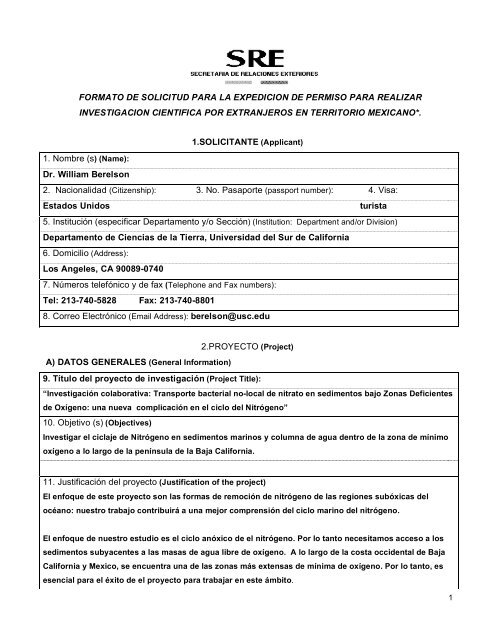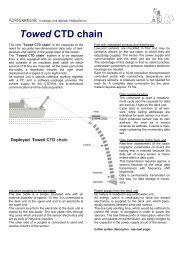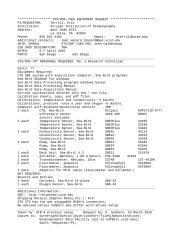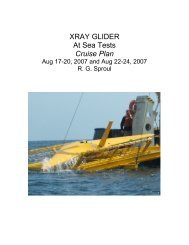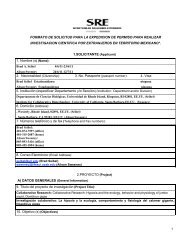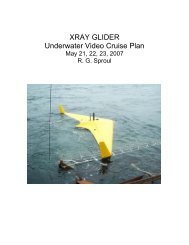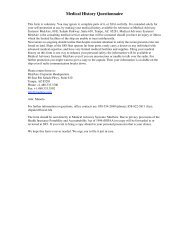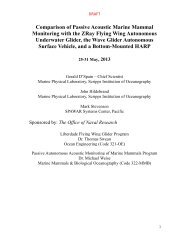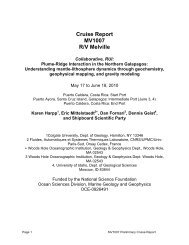formato de solicitud para la expedicion de permiso - SIO Ship ...
formato de solicitud para la expedicion de permiso - SIO Ship ...
formato de solicitud para la expedicion de permiso - SIO Ship ...
You also want an ePaper? Increase the reach of your titles
YUMPU automatically turns print PDFs into web optimized ePapers that Google loves.
FORMATO DE SOLICITUD PARA LA EXPEDICION DE PERMISO PARA REALIZAR<br />
INVESTIGACION CIENTIFICA POR EXTRANJEROS EN TERRITORIO MEXICANO*.<br />
1. Nombre (s) (Name):<br />
Dr. William Berelson<br />
1.SOLICITANTE (Applicant)<br />
2. Nacionalidad (Citizenship): 3. No. Pasaporte (passport number): 4. Visa:<br />
Estados Unidos turista<br />
5. Institución (especificar Departamento y/o Sección) (Institution: Department and/or Division)<br />
Departamento <strong>de</strong> Ciencias <strong>de</strong> <strong>la</strong> Tierra, Universidad <strong>de</strong>l Sur <strong>de</strong> California<br />
6. Domicilio (Address):<br />
Los Angeles, CA 90089-0740<br />
7. Números telefónico y <strong>de</strong> fax (Telephone and Fax numbers):<br />
Tel: 213-740-5828 Fax: 213-740-8801<br />
8. Correo Electrónico (Email Address): berelson@usc.edu<br />
A) DATOS GENERALES (General Information)<br />
2.PROYECTO (Project)<br />
9. Título <strong>de</strong>l proyecto <strong>de</strong> investigación (Project Title):<br />
“Investigación co<strong>la</strong>borativa: Transporte bacterial no-local <strong>de</strong> nitrato en sedimentos bajo Zonas Deficientes<br />
<strong>de</strong> Oxígeno: una nueva complicación en el ciclo <strong>de</strong>l Nitrógeno”<br />
10. Objetivo (s) (Objectives)<br />
Investigar el cic<strong>la</strong>je <strong>de</strong> Nitrógeno en sedimentos marinos y columna <strong>de</strong> agua <strong>de</strong>ntro <strong>de</strong> <strong>la</strong> zona <strong>de</strong> mínimo<br />
oxígeno a lo <strong>la</strong>rgo <strong>de</strong> <strong>la</strong> penínsu<strong>la</strong> <strong>de</strong> <strong>la</strong> Baja California.<br />
11. Justificación <strong>de</strong>l proyecto (Justification of the project)<br />
El enfoque <strong>de</strong> este proyecto son <strong>la</strong>s formas <strong>de</strong> remoción <strong>de</strong> nitrógeno <strong>de</strong> <strong>la</strong>s regiones subóxicas <strong>de</strong>l<br />
océano: nuestro trabajo contribuirá a una mejor comprensión <strong>de</strong>l ciclo marino <strong>de</strong>l nitrógeno.<br />
El enfoque <strong>de</strong> nuestro estudio es el ciclo anóxico <strong>de</strong> el nitrógeno. Por lo tanto necesitamos acceso a los<br />
sedimentos subyacentes a <strong>la</strong>s masas <strong>de</strong> agua libre <strong>de</strong> oxígeno. A lo <strong>la</strong>rgo <strong>de</strong> <strong>la</strong> costa occi<strong>de</strong>ntal <strong>de</strong> Baja<br />
California y Mexico, se encuentra una <strong>de</strong> <strong>la</strong>s zonas más extensas <strong>de</strong> mínima <strong>de</strong> oxígeno. Por lo tanto, es<br />
esencial <strong>para</strong> el éxito <strong>de</strong> el proyecto <strong>para</strong> trabajar en este ámbito.<br />
1
12. Período <strong>de</strong> <strong>la</strong> investigación (indicar inicio y término) (Research time frame)<br />
Aproximadamente14 días entre 10 <strong>de</strong> Octubre al 9 <strong>de</strong> Noviembre <strong>de</strong>l 2009<br />
13. Tema: Ocenografía X Hidrografía Ο Sismología Ο Geología Ο<br />
(Theme): Oceanography Hydrography Seismology Geology<br />
Geofísica Ο Batimetría Ο Otro Ο Especificar______________<br />
Geophysics Bathymetry Other Specify<br />
14. Lugar (es) <strong>de</strong> investigación (especificar Estados, Municipios y coor<strong>de</strong>nadas geográficas):<br />
(Research sites: State, Municipality, and geographic coordinates): Aguas costeras <strong>de</strong> Baja California<br />
2
y Baja California Sur; el trabajo se <strong>de</strong>sarrol<strong>la</strong>rá so<strong>la</strong>mente a bordo <strong>de</strong> <strong>la</strong> embarcación, partiendo <strong>de</strong><br />
Mazatlán, Sinaloa.<br />
Lat, N Long, W Nombre<br />
Sitio 4 33.835 119.028 Cuenca Santa Monica<br />
Sitio 3 25.080 112.950 Cuenca Soledad<br />
Sitio 2 23.420 111.230 Margen Magdalena<br />
Sitio 2a 23.160 110.950 Margen Magdalena<br />
Sitio 1a 24.170 108.120 Cuenca Pesca<strong>de</strong>ro<br />
15. La zona incluye is<strong>la</strong>s mexicanas: SI Ο NO X<br />
(Does the area inclu<strong>de</strong> Mexican is<strong>la</strong>nds): Yes No<br />
16. De ser afirmativa <strong>la</strong> respuesta, especificar los nombres <strong>de</strong> <strong>la</strong>s is<strong>la</strong>s y su ubicación:<br />
(In case of an affirmative response, indicate names of is<strong>la</strong>nds and their locations):<br />
No aplica<br />
Santa<br />
Monica<br />
Soledad<br />
Magdalena<br />
Pesca<strong>de</strong>ro<br />
3
17. Descripción breve <strong>de</strong> <strong>la</strong> metodología a utilizar (Brief <strong>de</strong>scription of methodology): Colecta <strong>de</strong> agua<br />
Con roseta CTD, toma <strong>de</strong> testigos con nucleadores multiple y <strong>de</strong> gravedad.<br />
18. Datos <strong>de</strong> los investigadores que co<strong>la</strong>borarían con el titu<strong>la</strong>r (especificar nacionalidad, especialidad,<br />
institución en <strong>la</strong> que co<strong>la</strong>boran y <strong>la</strong>s activida<strong>de</strong>s que cada uno <strong>de</strong>sarrol<strong>la</strong>ría):<br />
(Participants’ information: nationality, specialty, institution, and activities to be conducted):<br />
4
Lista <strong>de</strong> participantes<br />
Participante Institución Nacionalidad Puesto, experiencia<br />
Jefe <strong>de</strong> científicos, trabajo<br />
1 Berelson, William (IP) USC EU<br />
<strong>de</strong> cámara béntica, TCO2<br />
2 Prokopenko, Maria Oregon State University EU Nucleado, Análisis <strong>de</strong> N2<br />
3 McManus, James (IP) USC<br />
Univ. A. <strong>de</strong> Baja<br />
EU Geoquímica, metales traza<br />
4 Gonzalez-Yajimovich, Oscar California México Nucleado, Sedimentólogo<br />
Estudiante <strong>de</strong> posgrado,<br />
5 Krista Wolfe USC EU<br />
Geoquímica<br />
Estudiante <strong>de</strong> posgrado,<br />
6 Chong, Laurie USC EU<br />
Geoquímica<br />
7 Orphan, Victoria Caltech<br />
Univ. A. <strong>de</strong> Baja<br />
EU Biología molecu<strong>la</strong>r<br />
8 Mejia Piña, Kar<strong>la</strong> Gabrie<strong>la</strong> California<br />
Univ. A. <strong>de</strong> Baja<br />
México Estudiante <strong>de</strong> Oceanología<br />
9 Alejandro Aldama Cervantes California México Estudiante <strong>de</strong> Oceanología<br />
10 Alperin, Marc UNC EU Geoquímica, S species<br />
Estudiante <strong>de</strong> posgrado,<br />
11 Rie<strong>de</strong>l, Tim USC EU<br />
Geoquímica, oxígeno<br />
Columna <strong>de</strong> agua, metales<br />
12 Sanudo Wilhelmy, Sergio USC México<br />
traza<br />
13 Dawson, Scott UC-Davis EU Biología molecu<strong>la</strong>r<br />
Estudiante <strong>de</strong> posgrado,<br />
14 Singer, Esther USC<br />
Univ. of Southern<br />
Alemania Geoquímica<br />
15 Thamdrup, Bo<br />
Denmark Dinamarca Análisis Nitrógeno<br />
16 Pendiente<br />
17 Johnston, Dave<br />
Estudiante <strong>de</strong> posgrado <strong>de</strong><br />
Harvard EU Química <strong>de</strong> azufre<br />
18 USC USC EU Geoquímica General<br />
Los Investigadores Principales (IP) compartirán responsabilida<strong>de</strong>s entre ellos <strong>para</strong> asegurar un crucero exitoso y<br />
consultarán con Gonzalez-Yajimovich sobre todas <strong>la</strong>s activida<strong>de</strong>s.<br />
IP—Berelson es experto en <strong>la</strong> toma <strong>de</strong> núcleos, muestreo hidrográfico, muestreo y experimentos con cámara<br />
béntica. El dirigirá todos los esfuerzos <strong>de</strong> <strong>la</strong> cámara béntica en el crucero y supervisará todas <strong>la</strong>s mediciones<br />
analíticas <strong>de</strong> TCO2, pH y oxígeno que se lleven a cabo a bordo. También será responsable <strong>de</strong> muestrear los<br />
núcleos <strong>de</strong> gravedad <strong>para</strong> el análisis <strong>de</strong> agua <strong>de</strong> poro.<br />
IP—Prokopenko tiene mucha experiencia en hidrografía y nucleado. El<strong>la</strong> dirigirá <strong>la</strong>s operaciones <strong>de</strong> nucleado<br />
múltiple y supervisará <strong>la</strong> extracción <strong>de</strong> agua <strong>de</strong> poro <strong>de</strong> los núcleos, incubaciones <strong>de</strong> los núcleos y los análisis <strong>de</strong><br />
amonio y N2 a bordo.<br />
IP—McManus ha trabajado con Berelson y Prokopenko en cruceros previos y tiene experiencia en todos los<br />
aspectos <strong>de</strong> este esfuerzo científico. El supervisará el muestreo hidrográfico y el nucleado <strong>de</strong> pistón (gravedad),<br />
supervisará el manejo <strong>de</strong> todas <strong>la</strong>s muestras <strong>de</strong> agua <strong>para</strong> el análisis <strong>de</strong> metales traza y ayudará en <strong>la</strong> supervisión<br />
<strong>de</strong> <strong>la</strong>s operaciones <strong>de</strong> cubierta durante los <strong>la</strong>nces <strong>de</strong> <strong>la</strong> cámara béntica.<br />
IP—Gonzalez-Yajimovich ha trabajado en cruceros previos con Berelson y Prokopenko en los cuales se logró<br />
recobrar muchos núcleos. El ayudará a supervisar <strong>la</strong> toma <strong>de</strong> testigos con nucleador múltiple y <strong>de</strong> gravedad y será<br />
responsable <strong>de</strong> todo el muestreo <strong>de</strong> fase sólida <strong>de</strong> sedimentos <strong>para</strong> ser utilizados en análisis sedimentológicos,<br />
incluyendo C, N, CaCO3 y Si biogénico.<br />
5
19. Fuente <strong>de</strong> financiamiento <strong>de</strong>l proyecto (Funding sources):<br />
National Science Foundation, USA<br />
20. Nombres <strong>de</strong> los participantes mexicanos (especificar <strong>la</strong>s instituciones a <strong>la</strong>s que pertenecen):<br />
(Name of the Mexican participants and their institutions)<br />
Dr. Oscar Gonzalez–Yajimovich, Universidad Autónoma <strong>de</strong> Baja California, Facultad <strong>de</strong> Ciencias Marinas,<br />
Ensenada.<br />
21. Especificar si se realizarán estudios y/o exploraciones geográficas en Territorio Mexicano:<br />
(Specify if any geographic studies and/or explorations will be ma<strong>de</strong> within Mexican Territory)<br />
Ninguna<br />
22. Especificar si se realizarán levantamientos aéreos <strong>de</strong> información geográfica en México:<br />
(Specify if any geographic information aerial surveys will be ma<strong>de</strong> in México)<br />
Ninguno<br />
B) COLECTA (Collections)<br />
23. Flora Fauna<br />
Terrestre Ο (terrestrial) Terrestre Ο (terrestrial)<br />
Marina Ο (marine) Marina Ο (marine)<br />
Ejemp<strong>la</strong>res vivos Ο (alive) Ejemp<strong>la</strong>res muertos Ο (<strong>de</strong>ad)<br />
Ejemp<strong>la</strong>res completos Ο (complete) Partes o muestras Ο (samples)<br />
Otros X (others) Especificar: (specify) Agua y sedimentos<br />
24. Ejemp<strong>la</strong>res que se colectarían (en caso <strong>de</strong> que el espacio sea insuficiente, adjuntar un listado):<br />
(Species to be collected) (if the space is insufficient, attach a list)<br />
Nombre científico<br />
(Scientific Name)<br />
Nombre común<br />
(Common name)<br />
Cantidad a colectar<br />
(Number of<br />
specimens)<br />
Localidad a <strong>la</strong> que pertenece<br />
(Location)<br />
25. Destino final <strong>de</strong>l material colectado (Final <strong>de</strong>stination of the collected material):<br />
6
Se tras<strong>la</strong>dará el material colectado al extranjero: SI X NO O<br />
(Will the collected material be transported to a foreign country): Los testigos <strong>de</strong> sedimento y aqua serán<br />
transportados a <strong>la</strong> Universidad <strong>de</strong>l Sur <strong>de</strong> California <strong>para</strong> su análisis y <strong>de</strong> ahí serán enviados al Dr. Oscar<br />
Gonzalez–Yajimovich, <strong>para</strong> ser <strong>de</strong>positados en <strong>la</strong> Facultad <strong>de</strong> Ciencias Marinas <strong>de</strong> <strong>la</strong> Universidad<br />
Autónoma <strong>de</strong> Baja California. Muestras <strong>de</strong> agua <strong>de</strong> mar serán llevadas a USC <strong>para</strong> su análisis <strong>de</strong> nitrógeno<br />
disuelto y posteriormente serán <strong>de</strong>sechadas.<br />
Si <strong>la</strong> respuesta es negativa, pasar al punto 26<br />
(if the anser is NO, skip to item 26)<br />
Las muestras permanecerán en el extranjero <strong>de</strong> manera: Temporal X Definitiva Ο<br />
Samples will remain overseas: Temporarily X Permanently<br />
Ubicación <strong>de</strong> <strong>la</strong> aduana mexicana por <strong>la</strong> que saldría el material colectado y seña<strong>la</strong>r <strong>la</strong> fecha <strong>de</strong> salida:<br />
(Mexican point of exit, and estimated <strong>de</strong>parture date):<br />
Ninguna<br />
Sitio y tiempo <strong>de</strong> permanencia en el extranjero <strong>de</strong>l material colectado:<br />
(P<strong>la</strong>ce and time frame where the collected material will be <strong>de</strong>posited):<br />
Ninguno<br />
26. Instituciones mexicanas en <strong>la</strong>s que se efectuarán los <strong>de</strong>pósitos correspondientes <strong>de</strong>l material<br />
colectado:<br />
(Mexican institutions where the collected material will be <strong>de</strong>posited)<br />
Facultad <strong>de</strong> Ciencias Marinas <strong>de</strong> <strong>la</strong> Universidad Autónoma <strong>de</strong> Baja California<br />
27. Con base en el artículo 28 <strong>de</strong> <strong>la</strong> Ley General <strong>de</strong>l Equilibrio Ecológico y <strong>la</strong> Protección al Ambiente<br />
<strong>de</strong>berá indicar si <strong>la</strong>s activida<strong>de</strong>s, métodos, tecnologías y otras herramientas utilizadas <strong>para</strong> el <strong>de</strong>sarrollo<br />
<strong>de</strong> su proyecto pue<strong>de</strong>n tener un efecto negativo al medio ambiente SI Ο NO X<br />
(Based on Article 28 of the General Law of Ecological Ba<strong>la</strong>nce and Environmental Protection you must indicate if<br />
the activities, methods, technology, and other tools to be used for the <strong>de</strong>velopment of your project may have a<br />
negative impact on the environment)<br />
Si <strong>la</strong> respuesta es afirmativa se <strong>de</strong>berá adjuntar y/o solicitar una Manifestación <strong>de</strong> Impacto Ambiental.**<br />
(If the response is affirmative you must inclu<strong>de</strong> and/or request an Environmental Impact Assessment.**)<br />
Ninguno<br />
C) VEHÍCULOS (VEHICLES)<br />
7
28. Buque X Aeronave Ο Automóvil Ο Otro Ο<br />
especificar:__________________<br />
specify:<br />
<strong>Ship</strong> Aircraft Automobile Other<br />
EMBARCACIONES (<strong>Ship</strong>s)<br />
29. Nombre <strong>de</strong> <strong>la</strong>(s) embarcación(es) (ship's name):<br />
R/V New Horizon<br />
30. Institución que lo opera (Operating institution):<br />
Universidad <strong>de</strong> California San Diego, Instituto <strong>de</strong> Oceanografía Scripps<br />
31. Propietario (indicar nombre y nacionalidad) (Owner’s name and nationality):<br />
Regentes <strong>de</strong> <strong>la</strong> UCSD,EU<br />
32. Número <strong>de</strong> matrícu<strong>la</strong> (registration number): WKWB<br />
33. Número <strong>de</strong> tripu<strong>la</strong>ntes (number of crew): 12 tripu<strong>la</strong>ntes, más 18 científicos<br />
34. Nombre <strong>de</strong>l capitán (Captain’s name): John Manion<br />
35. Frecuencias que utilizaría (frequencies):<br />
Email master@rv-newhorizon.ucsd.edu<br />
http://www.sio.ucsd.edu/shipsked/general/communications.html<br />
1556462 (AnsBk=GOGO)<br />
Inmarsat-B<br />
Teléfono<br />
At<strong>la</strong>ntic - East 011-871-330327320<br />
At<strong>la</strong>ntic - West 011-874-330327320<br />
Pacific 011-872-330327320<br />
Indian 011-873-330327320<br />
Alternate<br />
Fax<br />
Primary 011-XXX-330327321<br />
MMSI # 303273000<br />
SELCAL # 71478<br />
36. Puerto(s) que visitaría (Port calls):<br />
Mazatlán, Sinaloa Mexico y San Diego, California, EU<br />
AERONAVES (Aircraft):<br />
8
37. Mo<strong>de</strong>lo <strong>de</strong> <strong>la</strong> aeronave, características y <strong>de</strong>scripción <strong>de</strong>l equipo a utilizar:<br />
(Mo<strong>de</strong>l, characteristics, and <strong>de</strong>scription of equipment):<br />
Ninguno<br />
38. Número <strong>de</strong> matrícu<strong>la</strong> (adjuntar copia <strong>de</strong>l certificado):<br />
(Registration number) (attach copy of the certificate)<br />
Ninguno<br />
39. Propietario u organismo al que pertenece: (Owner’s name and institution)<br />
Ninguno<br />
40. Grado y nombre <strong>de</strong>l piloto: (Pilot’s name and gra<strong>de</strong>)<br />
Ninguno<br />
41. Tripu<strong>la</strong>ción y pasajeros (indicar sus nombres y activida<strong>de</strong>s que <strong>de</strong>sarrol<strong>la</strong>rían:<br />
(Crew members and participants) (names and activities to be conducted)<br />
Ninguno<br />
42. Si aterrizará en jurisdicción nacional, especificar el(los) nombre(s) <strong>de</strong>l(los) Aeropuerto(s) que<br />
utilizaría y <strong>la</strong>s fechas <strong>de</strong> entradas y salidas:<br />
(In case of <strong>la</strong>nding in Mexico, indicate name (s) of the airport (s) that will be used, as well as dates of entry<br />
and <strong>de</strong>parture)<br />
Ninguno<br />
43. Proce<strong>de</strong>ncia (From):<br />
Ninguno<br />
44. Ruta (route):<br />
Ninguno<br />
45. Destino (<strong>de</strong>stination)<br />
Ninguno<br />
OTROS. (Others)<br />
46. Características (characteristics):<br />
Ninguno<br />
47. Registro y/o matrícu<strong>la</strong> (Registration):<br />
9
Ninguno<br />
48. Propietario (Owner)<br />
Ninguno<br />
3. LA SIGUIENTE SECCIÓN DEBERÁ SER LLENADA POR LA EMBAJADA<br />
(The following section must be completed by the Embassy)<br />
49. Indicar si el proyecto se realizaría en el marco <strong>de</strong> algún acuerdo bi<strong>la</strong>teral o multi<strong>la</strong>teral y<br />
proporcionar los datos <strong>de</strong>l mismo: (Indicate if the project will be conducted un<strong>de</strong>r any bi<strong>la</strong>teral or<br />
multi<strong>la</strong>teral agreement and provi<strong>de</strong> information on the same)<br />
Ninguno<br />
50.El proyecto es continuación <strong>de</strong> alguna investigación previa:<br />
(Is the project a continuation of any previous research)<br />
SI Ο NO Ο<br />
51. En caso <strong>de</strong> que <strong>la</strong> respuesta sea afirmativa, proporcionar información <strong>de</strong> <strong>la</strong> investigación previa<br />
(incluya nombre <strong>de</strong>l titu<strong>la</strong>r, objetivo, período(s) y sitio(s) <strong>de</strong> trabajo.<br />
(If the answer is affirmative, provi<strong>de</strong> information on the previous research) (name of scientist, purpose,<br />
research time frame, and research sites)<br />
Ninguno<br />
52. Especificar si se han remitido a <strong>la</strong> Secretaría <strong>de</strong> Re<strong>la</strong>ciones Exteriores todos los informes<br />
correspondientes:<br />
((Indicate if all the reports have been submitted to the Secretariat of Foreign Re<strong>la</strong>tions)<br />
SI Ο NO Ο<br />
10
53. Proporcionar los datos <strong>de</strong> <strong>la</strong>s respectivas notas diplomáticas:<br />
(Provi<strong>de</strong> information on the applicable diplomatic notes)<br />
54. Observaciones (Observations):<br />
Accesorios:<br />
Adjuntar el curriculum vitae que incluya <strong>la</strong> nacionalidad, y dos fotografías tamaño<br />
pasaporte <strong>de</strong>l investigador titu<strong>la</strong>r.<br />
CURRICULUM VITAE<br />
William M. Berelson<br />
Address: Department of Earth Sciences<br />
University of Southern California<br />
Los Angeles, CA 90089-0740<br />
(213) 740-5828; berelson@usc.edu<br />
Education: University of Rochester Geology B.A. (cum <strong>la</strong>u<strong>de</strong>) 1977<br />
Duke University Geology M.S. 1979<br />
11
U. Southern California Geochemistry Ph.D. 1985<br />
Appointments:<br />
2008-present Professor of Geobiology, University of Southern California<br />
2004- 2008 Associate Professor of Geobiology, University of Southern California<br />
1996-2004 Research Associate Professor, University of Southern California<br />
1988-1995 Research Assistant Professor, University of Southern California<br />
1985-1987 Post-doc, University of Southern California<br />
SELECTED PUBLICATIONS (5 most closely re<strong>la</strong>ted to this project):<br />
Nealson, K. and W. Berelson (2008) Sedimentary Habitats (accepted: Encyclopedia of Microbiology)<br />
Berelson, W. M., W. M. Balch, R. Najjar, R. Feely, C. Sabine and K. Lee (2007). Re<strong>la</strong>ting estimates of CaCO3<br />
production, export, and dissolution in the water column to measurements of CaCO3 rain into sediment traps and<br />
dissolution on the sea floor: A revised global carbonate budget. Global Biogeochemical Cycles, v. 21, GB1024,<br />
doi:10.1029/2006GB002803<br />
Prokopenko, M.G., Hammond, D.E., Berelson, W.M., Bernhard, J.M., Stott, L., Doug<strong>la</strong>s, R. (2006) Nitrogen<br />
cycling in the sediments of Santa Barbara Basin and Eastern Subtropical North Pacific – Isotopic evi<strong>de</strong>nce for<br />
chemosymbiosis between two lithotrophs: riding on a gli<strong>de</strong>r, Earth P<strong>la</strong>netary Sci. Lett., 242 (1-2), pp. 186-204.<br />
Berelson, W. M., Prokopenko, M., Graham, A., Sansone, F. J., McManus, J., Bernhard, J. M. (2005) Anaerobic<br />
diagenesis of silica and carbon in continental margin sediments: Discrete zones of TCO2 production. Geochim.<br />
Cosmochim. Acta, 69, 4611-4629.<br />
Berelson, W., R. An<strong>de</strong>rson, J. Dymond, D. DeMaster, D. Hammond, R. Collier, S. Honjo, M. Leinen, J.<br />
McManus, R. Pope, C. Smith and M. Stephens (1997) Biogenic budgets of particle rain, benthic remineralization<br />
and sediment accumu<strong>la</strong>tion in the Equatorial Pacific. Deep-Sea Research, v. 44, 2251-2282.<br />
(5 other publications also relevant to this proposal)<br />
Elrod, V. A., W. M. Berelson, K. H. Coale and K. S. Johnson (2004) The flux of iron from continental shelf<br />
sediments: A missing source for global budgets. Geophysical Research Letters, v. 31, L12307,<br />
doi:10.1029/2004GK020216, 2004<br />
McManus, J., W. M. Berelson, G.P. Klinkhammer, D. E. Hammond, and C. Holm (2005). Authigenic uranium:<br />
Re<strong>la</strong>tionship to oxygen penetration <strong>de</strong>pth and organic carbon rain. Geochim. Cosmochim. Acta, 69, 95-108.<br />
Feely, R., C. Sabine, K. Lee, W. Berelson, J. Kleypas, V. Fabry and F. Millero (2004). Impact of anthropogenic<br />
CO2 on the CaCO3 system in the oceans. Science, 305, 362-366.<br />
Berelson, W. and L. Stott (2003) Productivity and organic carbon rain to the California margin sea floor: Mo<strong>de</strong>rn<br />
and paleoceanographic perspectives. Paleoceanography, v. 18, 1002, doi:10.1029/2001PA000672 2003<br />
Berelson, W., J. McManus, K. Coale, K. Johnson, D. Burdige, T. Kilgore, D. Colodner, F. Chavez, R. Ku<strong>de</strong><strong>la</strong> and<br />
J. Boucher (2003). A time-series of benthic flux measurements from Monterey Bay, CA. Continental Shelf<br />
Research, v. 23, 457-481.<br />
SYNERGISTIC ACTIVITIES:<br />
Co-Director/Instructor-International GeoBiology Summer course on Catalina Is<strong>la</strong>nd; sponsored by Agouron<br />
Institute and USC Wrigley Institute for Environmental Studies. A 6-week c<strong>la</strong>ss taught by various instructors with<br />
20 stu<strong>de</strong>nts from an international pool of applicants. This intensive course involved lectures, <strong>la</strong>bs, field trips and<br />
in<strong>de</strong>pen<strong>de</strong>nt research for advanced graduate and post-doctoral stu<strong>de</strong>nts. I worked on logistics to make this<br />
course happen, gave lectures, sponsored field and <strong>la</strong>b research, mentored stu<strong>de</strong>nts. This course has been held<br />
6 years in a row with an applicant pool of 50-60 well qualified stu<strong>de</strong>nts applying each year. Stu<strong>de</strong>nts accepted<br />
study at Harvard, MIT, Stanford, USC, Dartmouth, UT-Austin, U. Washington, Scripps, UNC, ETH etc. and we<br />
12
have inclu<strong>de</strong>d international stu<strong>de</strong>nts from Chile, Uruguay, Peru, Greece, Cameroon, Indonesia and Turkey. The<br />
summer course recently obtained funding from NSF to augment the financial support supplied by Agouron. The<br />
NSF support is for 2005, 2006 and recently, 2008. In the fall, 2004 I taught ‘Crises of a P<strong>la</strong>net’, an<br />
environmental geology course to 240 un<strong>de</strong>rgraduate stu<strong>de</strong>nts. This course inclu<strong>de</strong>d a weekly <strong>la</strong>b and a field trip<br />
in which a polluted <strong>la</strong>ke was sampled for water chemistry and sediment properties. I also teach ‘Oceanography’<br />
to USC un<strong>de</strong>rgraduates and various graduate courses.<br />
I have worked as a volunteer for the Ocean Sciences Bowl, and event for high school stu<strong>de</strong>nts who compete to<br />
represent their school nationally by answering ocean-re<strong>la</strong>ted questions. Our <strong>la</strong>b is setting up a mentoring<br />
program for high school women who intern during summer.<br />
AWARDS/HONORS/AFFLIATIONS:<br />
Associate Editor (2 terms) -- (Reviews of Geophysics)<br />
Cited: CSIRO award for Port Phillip Bay Environmental Study (1995)<br />
GENERAL RESEARCH INTERESTS<br />
*GeoBiology; Layered Microbial Communities; Microbial respiration<br />
*Global budgets of carbon, silica, nitrogen and phosphorus: the role of sediment diagenesis<br />
*Factors that control the cycling of metals and nutrients in sediments<br />
*Calcium carbonate dissolution kinetics and its impact on paleoceanographic reconstruction<br />
*In situ <strong>de</strong>vice technology, Robotics<br />
*Radioisotopes and other tracers for mixing and advection in marine waters and sediments<br />
RECENT COLLABORATORS AND CO-AUTHORS<br />
D. Herron (Duke, MS-advisor), D. Hammond (USC-PhD advisor), J. McManus (OSU), V. Orphan (Caltech), F.<br />
Sansone (U. Hawaii), D. Feely (PMEL), C. Sabine (PMEL), R. Najjar (PSU), B. Balch (Bigelow), M. Prokopenko<br />
(Princeton), S. Dixit (LBNL), M. Alperin (UNC), D. Sigman (Princeton)<br />
13
01/22/2008 Curriculum Vitae<br />
Maria G. Prokopenko (323) 630-4968<br />
Education:<br />
Ph.D., Earth Sciences, University of Southern California, Los Angeles 2004<br />
M.S., Geology, University of Cincinnati, Cincinnati 1998<br />
B.A., Trans<strong>la</strong>tion/Interpretation in English, Institute of Foreign<br />
Languages, Moscow, Russia 1995<br />
B.S., Geology, Moscow State University, Russia 1992<br />
Appointments<br />
2008 – present Provost Postdoctoral Fellow, Department of Earth Sciences, USC<br />
2007 – 2008 Postdoctoral Fellow, Department of Earth Sciences, USC<br />
2005 – 2007 Hess Postdoctoral Fellow, Department of Geosciences, Princeton University<br />
2001 – 2004 Research Assistant, Department of Earth Sciences, USC<br />
Teaching experience<br />
2006-2007 Mentor of an un<strong>de</strong>rgraduate senior thesis project, Department of Geosciences, Princeton<br />
University<br />
Summer 2005 Instructor of geochemistry, Geobiology 2005: An international training course in rapidly<br />
evolving field, USC-Wrigley Institute for marine studies, Catalina Is<strong>la</strong>nd, sponsored by NSF<br />
and Agouron Institute<br />
Summer 2004 REU(Research Experience for Un<strong>de</strong>rgraduates) mentor, USC, sponsored by NSF<br />
Summer 2003/4 Teaching assistant in geochemistry, International Geobiology course, USC-Wrigley Institute<br />
for marine studies, Catalina Is<strong>la</strong>nd, sponsored by NSF and Agouron Institute<br />
1998-2000 Teaching assistant: Climate Change, Introduction to Oceanography, Geology for Engineers,<br />
Department of Earth Sciences, USC<br />
1995-1997 Teaching Assistant: Introduction to geology, Structural geology<br />
Department of Geology, University of Cincinnati<br />
Sea going experience:<br />
Spring 2008 US Coast Guard Healy, Geochemist, continuous dissolved gases analysis on MIMS, Bering<br />
Sea<br />
Spring 2007 US Coast Guard Healy, Geochemist, continuous dissolved gases analysis on MIMS, Bering<br />
Sea<br />
Spring 2005 R/V New Horizon, Geochemist, California Bor<strong>de</strong>r<strong>la</strong>nd Basins<br />
Spring 2003 R/V Wecoma, Co-chief scientist, California Bor<strong>de</strong>r<strong>la</strong>nd Basins<br />
Fall 2001 R/V New Horizon, Geochemist, Gulf of California<br />
Summer 2001 R/V Point Sur, Geochemist, California Bor<strong>de</strong>r<strong>la</strong>nd Basins<br />
Fall 2000 R/V Sproul, co-proponent and participant, Santa Barbara Basin<br />
14
Fellowships and honors<br />
2005-2007 Harry Hess Fellowship, Department of Geosciences, Princeton University<br />
2004 Sonorsky Summer Fellowship at the Department of Earth Sciences , USC<br />
2002-2003 Sch<strong>la</strong>nger ODP fellowship, Joint Oceanographic Institutions<br />
Spring 2000 Outstanding Teaching Assistant Award, Department of Geosciences, USC<br />
Summer 1997 NASA P<strong>la</strong>netary Biology Internship, Center for Great Lake Studies, Laboratory of Ken<br />
Nealson<br />
Publications<br />
Peer-reviewed:<br />
Prokopenko, M.G., Hammond, D.E., Berelson, W.M., Bernhard, J.M., Stott, L., Doug<strong>la</strong>s, R, 2006,<br />
“Nitrogen cycling in the sediments of Santa Barbara basin and Eastern Subtropical North<br />
Pacific: Nitrogen isotopes, diagenesis and possible chemosymbiosis between two lithotrophs<br />
(Thioploca and Anammox)—“riding on a gli<strong>de</strong>r”, Earth and P<strong>la</strong>netary Science Letters, 242 (1-<br />
2), pp. 186-204<br />
Prokopenko, M.G., Hammond, D.E., Spivack, A., and Stott, L., 2006. Impact of long-term diagenesis on δ 15 N<br />
of organic matter in marine sediments: Sites 1227 and 1230. In Jørgensen, B.B., D'Hondt, S.L., and<br />
Miller, D.J. (Eds.), Proc. ODP, Scientific Results, 201: College Station, TX (Ocean DrillingProgram)<br />
Prokopenko, M.G., Hammond, D.E. and Stott, L., 2006. Lack of isotopic fractionation of δ 15 Ν of organic<br />
matter during long-term diagenesis in marine sediments, ODP Leg 202, Sites 1234 and 1235. In<br />
Tie<strong>de</strong>mann, R., Mix, A.C., Richter, C., and Ruddiman, W.F. (Eds.), Proc. ODP, Scientific Results,<br />
202: College Station, TX (Ocean DrillingProgram)<br />
Granger, J., Sigman, D.M., Prokopenko, M.G., Lehmann, M.F. and Tortell, P.D., 2006. A method for<br />
nitrite removal in nitrate N and O isotope analyses. Limnology and Oceanography-Methods, 4:<br />
205-212.<br />
Meister, P., Prokopenko, M., C.G. Skilbeck, M. Watson, and J.A. McKenzie, 2006, Data report: Compi<strong>la</strong>tion of<br />
Total Organic and Inorganic Carbon data from Peru margin and Eastern Equatorial Pacific drill. In<br />
Jørgensen, B.B., D'Hondt, S.L., and Miller, D.J. (Eds.), Proc. ODP, Scientific. Results, 201: College<br />
Station, TX (Ocean DrillingProgram)<br />
Berelson, W. M., Prokopenko, M., Graham, A., Sansone, F., McManus, J., Bernhard, J., 2005,<br />
“Anaerobic diagenesis of carbon and silica in continental margin sediments: Discrete zone of<br />
TCO2 production”, Geochim. Cosmoc.Acta, 96 (19), pp.4611-4629.<br />
Stott, L.D., Bunn, T., Prokopenko, M., Mahn C., Gieskes, J., Bernhard, J., 2002, “Does the oxidation of<br />
methane leave an isotopic fingerprint in the geologic record?”, Geochem, Geophys., Geosyst., 3(2), art.<br />
# 1012.<br />
Manuscripts in pre<strong>para</strong>tion:<br />
Prokopenko, Sigman, Berelson, Hammond, Ben<strong>de</strong>r, Barnett, Chong (in prep) “Contribution of nonlocal<br />
biological transport to sedimentary <strong>de</strong>nitrification: a missing nitrate sink?”<br />
Prokopenko, Granger, Mordy, Cassar, DeFiore, Ben<strong>de</strong>r, Shull, Cokelet, Kachel, Sigman, Sambrotto,<br />
Berelson, Moran (in prep) “Spring bloom dynamic in the marginal ice zones in the Bering Sea<br />
from triple oxygen isotopes and continuous measurements of O2/Ar ratios ”<br />
Prokopenko, M.G., Hammond, D. E., Mahaffey C., Walker L., Stott L. (in prep.) “N isotope<br />
fractionation during oxic and anoxic diagenesis of organic matter: results of <strong>la</strong>boratory<br />
incubation experiments”<br />
Talks and presentations<br />
Invited:<br />
Department of Ocean and Atmospheric Sciences, Weekly seminar, UCLA, “Application of triple oxygen<br />
isotopes and continuous O2/Ar measurements for monitoring spring bloom dynamics in the marginal ice<br />
zones in the Bering Sea”, 2009<br />
Gordon Conference in Chemical Oceanography, “The role of biological transport of nitrate in the sedimentary N<br />
15
cycle”, 2009<br />
Geological Society of America Annual Meeting, Denver, Colorado, “Biological transport of nitrate within<br />
sediments un<strong>de</strong>rlying oxygen <strong>de</strong>ficient zones: a new twist in the N cycle”, 2007<br />
Department of Ocean and Atmospheric Sciences, Weekly seminar, UCLA, “Non-diffusive nitrate transport and<br />
its role in benthic nitrogen cycling in the California Bor<strong>de</strong>r<strong>la</strong>nd Basins”, 2006<br />
Department of Geosciences, Princeton University, “Isotopic fractionation of nitrogen isotopes during early<br />
diagenesis in marine sediments: The story of two anoxic sites”, 2004<br />
Dissertation Symposium on Chemical Oceanography XVIII, Waikoloa, Hawaii, “Effects of early diagenetic<br />
processes on nitrogen isotopes in marine sediments”, 2003<br />
Contributed:<br />
2008<br />
Prokopenko, M.G., Granger, J., DiFiore, P., Mordy C., , Cassar N., Cokelet E., Kachel N., Kachel D.,<br />
Sambrotto, R., Moran B., 2006, “Spring Bloom Dynamics of the Eastern Bering Sea Shelf as Estimated<br />
Oxygen/Argon Ratios and Triple Oxygen Isotopes, AGU Fall Meeting 2008<br />
Berelson, W., Prokopenko, M.G., Sigman, S., Hammond, D., 2008, “Dissolved N2/Ar Ratios in<br />
Sedimentary Pore Waters: A New Twist in Marine Nitrogen Cycle”, AGU Fall Meeting 2008<br />
2006<br />
Prokopenko, M., D. Hammond, C. Mahaffey, L. Walker , 2006, “Nitrogen isotopic fractionation during<br />
oxic vs. anoxic diagenesis in recent marine sediments: results of incubation experiment”, Eos<br />
Trans. AGU, 87(36), Ocean Sci. Meet. Suppl., Abs. # OS42K-05<br />
Hammond, D.E., Prokopenko, M. and Berelson, W., 2006. Measuring pore water N2 profiles to constrain<br />
<strong>de</strong>nitrification pathways and rates in coastal sediments, Eos Trans. AGU, 87(36), Ocean Sci. Meet.<br />
Suppl., OS45J-06<br />
2005<br />
Prokopenko, M., Sigman, D.M., Hammond, D.E., Barnett, B., Ben<strong>de</strong>r, M., Berelson. W., 2005,<br />
“Pore water profiles of dissolved [N2] andδ 15 N-N2 in the Santa Barbara Basin: Evi<strong>de</strong>nce for nondiffusive<br />
nitrate flux into the sediment column”, Eos Trans. AGU, 86(52), Fall Meet. Suppl., Abstract<br />
B31A-0981<br />
2004<br />
Prokopenko, M.G., Hammond, D.E., Stott, L., Spivack, A.J., 2004, “Nitrogen isotopic composition of<br />
ammonium released during diagenesis of organic matter un<strong>de</strong>r steady-state and non-steady state<br />
conditions in anoxic marine sediments”, Eos Trans. AGU, 85(47), Fall Meet. Suppl., Abstract PP51G-<br />
04.<br />
Berelson, W., Prokopenko, M., Stevenson, B., Spear, J., Dawson, S., Hugenholtz, P., C<strong>la</strong>ss, G., 2004, Microbial<br />
Distributions Through Pore Water Geochemical Gradients: How Well do Contemporary Organism<br />
Genomes Track Their Environment? Eos Trans. AGU, 85(47), Fall Meet. Suppl., Abstract # B33B-<br />
0257<br />
2003 and before<br />
Prokopenko, M., Hammond, D.E., Berelson W., Souza-Egipsy, V., Stott, L., 2003, “Processes of early<br />
diagenesis affecting nitrogen isotopic composition of marine sediments”, Eos Trans. AGU, 84(52),<br />
Ocean Sci. Meet. Suppl., Abstract OS12-04, 2003<br />
Prokopenko M., Hammond D.E. and ODP Leg 201 <strong>Ship</strong>board Scientific Party, “Fractionation of nitrogen<br />
isotopes observed between pore water ammonium and solid phase nitrogen observed in sediments from<br />
Site 1227 ODP Leg 201”, GSA Annual meeting, Denver, CO, abstract # 216-5, 2002<br />
Huff, W. D., Prokopenko*, M. G.; Krekeler, Mark P. S.; Gerke, Tammie; Ko<strong>la</strong>ta, Dennis R.; Bergstrom, Stig<br />
M.; Cingo<strong>la</strong>ni, Carlos, 1997, “Geochemical and mineralogical variations in Ordovician K-bentonites<br />
from the Argentine Precordillera: explosive volcanism at the Iapetus margin”, GSA, 1997 Annual<br />
Meeting Abstracts with Programs, 29, no. 6, p. 210-211<br />
Prokopenko, M., Krekeler, M.P.S., Huff, W. P., Bergstrom, S.M., Ko<strong>la</strong>ta, D.R., Cingo<strong>la</strong>ni, C., Lehnert, O.T.H.,<br />
1997, "Ordovician K-bentonites in the Argentine Precordillera: Origin, Composition, Diagenesis, and<br />
16
Paleoenvironmental Implications", 11th International C<strong>la</strong>y Conference Program With Abstracts<br />
volume, 1997<br />
Prokopenko, M., Gaines, R., Krekeler, M.P.S., Huff, W.D., Ko<strong>la</strong>ta, DR, Bergstrom, S.M., Cingo<strong>la</strong>ni, C., 1996,<br />
“Microfossils in Middle Ordovician K-Bentonites from the Precordillera of Argentina”, GSA 1996<br />
Annual Meeting Abstracts with Programs, 28, n.7, p.295.<br />
Professional activities: Reviewer for Limnology and Oceanography<br />
Professional affiliations: American Geophysical Union, American Society for Limnology and Oceanography<br />
Advisors: Dr. William Berelson, postdoctoral advisor at USC<br />
Dr. Daniel Sigman, postdoctoral advisor at Princeton University<br />
Dr. Doug<strong>la</strong>s Hammond, Ph.D. advisor at University of Southern California<br />
Dr. Warren Huff, Master’s thesis advisor at University of Cincinnati<br />
Analytical and instrumental expertise<br />
Standard geochemical methods including gas chromatography; stable isotope analysis (including on-line<br />
and off-line sample pre<strong>para</strong>tion) of sedimentary organic matter, dissolved ammonium, nitrate and<br />
dissolved gases, sample pre<strong>para</strong>tion using “<strong>de</strong>nitrifier method”, operating and maintaining stable isotope<br />
mass spectrometers (Isoprime Micromass and Delta Plus) in various configurations (continuous flow<br />
interfaced with elemental analyzers or GasBench); operation and maintenance of Membrane Inlet Mass<br />
Spectrometer (MIMS); extraction and analysis of sedimentary DNA material, low level nitrate/nitrite<br />
measurements on the NOx box<br />
Curriculum Vita<br />
James McManus<br />
2009 INFORMATION<br />
Associate Program Director Professor, Marine Geology and Geophysics<br />
(Until June 30, 2009) (Currently at NSF, returning 1 July 2009)<br />
National Science Foundation (NSF) College of Oceanic and Atmos. Sci.<br />
Division of Ocean Sciences Oregon State University<br />
Chemical Oceanography Program Corvallis, OR 97331-5503<br />
4201 Wilson Blvd. (541) 737-8285<br />
Arlington, VA mcmanus@coas.oregonstate.edu<br />
jmcmanus@nsf.gov<br />
EDUCATION AND EMPLOYMENT INFORMATION<br />
17
Education<br />
1992 Ph.D. Oceanography, Oregon State University.<br />
1986 B.Sc. Chemistry (Distinction), Stockton State College.<br />
Aca<strong>de</strong>mic Positions<br />
2007-present Professor, Oregon State University<br />
2004-2007 Associate Professor, Oregon State University<br />
2002-2004 Assistant Professor, Oregon State University<br />
1998-2002 Assistant Professor, University of Minnesota Duluth<br />
1996-1998 Assistant Professor (Senior Research), Oregon State University.<br />
1994-1996 Research Associate (Post Doctoral), Oregon State University.<br />
1993-1993 Adjunct Faculty: El Camino Community College.<br />
1992-1994 Postdoctoral Reseach Associate: University of Southern California.<br />
1987-1992 Graduate Research Assistant: Oregon State University.<br />
Additional Positions and Appointments<br />
2008-present (until 30 June, 2009) Associate Program Director, Chemical Oceanography<br />
Program, National Science Foundation.<br />
2006 - 2008, Associate Editor Geochimica et Cosmochimica Acta<br />
July 2006 – July 2009, Member-at-Large American Society of Limnology and<br />
Oceanography<br />
RESEARCH<br />
My research focuses on a number of broad issues re<strong>la</strong>ted to the Earth's biogeochemical<br />
evolution. This research inclu<strong>de</strong>s specific studies on past climate and geochemical cycles,<br />
mo<strong>de</strong>rn geochemical processes, and how anthropogenic perturbations might influence<br />
biogeochemical cycles in the future. My research inclu<strong>de</strong>s examining elemental cycling in the<br />
ocean, estuaries, rivers, and <strong>la</strong>kes.<br />
Research interests (Selected topics):<br />
• Uranium, molyb<strong>de</strong>num, cadmium, and vanadium geochemistry in marine sediments.<br />
• Carbon, phosphorus, and trace metal cycling in Lakes.<br />
• Millennial-scale variations in intermediate water masses of the South Pacific.<br />
• Molyb<strong>de</strong>num stable isotope geochemistry in marine sediments.<br />
• Germanium geochemisty.<br />
• Iron and iron isotope geochemistry.<br />
Selected Peer Reviewed Journal Publications :<br />
Wheat, C.G. and J. McManus. 2008. Germanium in mid-ocean ridge f<strong>la</strong>nk<br />
hydrothermal fluids. Geochemistry, Geophysics, Geosystems. Volume 9, Number<br />
3, Q03025, doi:10.1029/2007GC001892.<br />
Severmann, S., T. W. Lyons, A. Anbar, J. McManus, G. Gordon. 2008. A mo<strong>de</strong>rn iron<br />
isotope perspective on the redox evolution of ancient oceans. Geology, June 2008;<br />
v. 36; no. 6; p. 487–490; doi: 10.1130/G24670A.1; 4 fi gures; Data Repository item<br />
2008110.<br />
McManus, J., W. M. Berelson, S. Severmann, R. Poulson, D. E. Hammond, C. Holm,<br />
and G. P. Klinkhammer. 2006. Molyb<strong>de</strong>num and uranium geochemistry in<br />
18
continental margin sediments: Paleoproxy potential. Geochim. Cosmochim. Acta.<br />
70: 4643-4662.<br />
Siebert, C., J. McManus, A. Bice, R. Poulson, and W. M. Berelson. 2006. Molyb<strong>de</strong>num<br />
isotope signatures in continental margin marine sediments. Earth and P<strong>la</strong>net. Sci.<br />
Letts. 241: 723-733.<br />
Wheat, C.G., and J. McManus. 2005. The role of ridge-f<strong>la</strong>nk hydrothermal systems on<br />
the oceanic germanium and silicon ba<strong>la</strong>nces. Geochim. Cosmochim. Acta, 69: 2021<br />
- 2029.<br />
McManus, J. William M. Berelson, Gary P. Klinkhammer, Doug<strong>la</strong>s E. Hammond, and<br />
Chris Holm. 2005. Authigenic uranium: Re<strong>la</strong>tionship to oxygen penetration <strong>de</strong>pth<br />
and organic carbon rain. Geochim. Cosmochim. Acta. 69: 95-108.<br />
McManus, J., D. E. Hammond, K. Cummins, G. P. Klinkhammer, and W. M. Berelson.<br />
2003 Diagenetic Ge-Si fractionation in continental margin environments: Further<br />
evi<strong>de</strong>nce for a non-opal Ge sink. Geochim. Cosmochim. Acta. 67: 4545-4557.<br />
McManus, J., E.A. Heinen, M. M. Baehr. 2003. Hypolimnetic oxidation rates in Lake<br />
Superior: Impact of dissolved organic material on the <strong>la</strong>ke's carbon budget. Limnol.<br />
Oceanogr. 48: 1624-1632.<br />
McManus, J., T.F. Nägler, C. Siebert, C.G. Wheat, D.E. Hammond. 2002. Oceanic<br />
molyb<strong>de</strong>num isotope fractionation: Diagenesis and hydrothermal ridge-f<strong>la</strong>nk<br />
alteration. Geochem., Geophys., Geosys. 3(12), 1078, doi:10.1029/2002GC000356.<br />
19
BUQUES, adjuntar el "Formato <strong>para</strong> solicitar autorización temporal <strong>de</strong> use <strong>de</strong><br />
radiofrecuencias, durante visitas <strong>de</strong> jefes <strong>de</strong> estado, operaciones <strong>de</strong> barcos e<br />
investigaciones científicas extranjeras" <strong>de</strong> <strong>la</strong> Comisión Fe<strong>de</strong>ral <strong>de</strong><br />
Telecomunicaciones (COFETEL).<br />
(SHIPS, attach the "Application for Temporary Approval for Use of Radio Frequencies<br />
during State Cabinet Members Visits, or operations of foreign research vessels", from<br />
the Fe<strong>de</strong>ral Telecommunications Comisión)<br />
22


